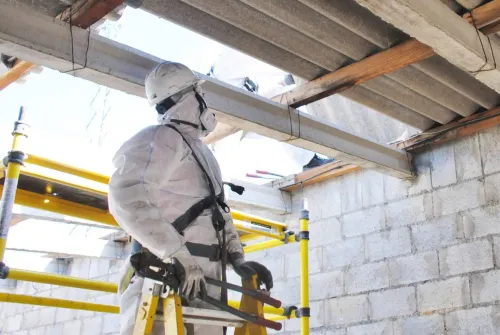Is Your Pet at Risk from Asbestos in Your Home?

When we think about asbestos, we often think about the health risks exposure has on us humans. However, it’s important to remember that asbestos doesn’t discriminate — our furry companions can also be at risk. Pets, like humans, can suffer from the harmful effects of asbestos exposure, including serious respiratory illnesses and cancer. If your home contains asbestos or you’re considering renovations in a property of any age, understanding how asbestos can affect your pets and the role of qualified asbestos abatement is crucial for keeping them safe.
In this blog, we’ll explore how pets can be exposed to asbestos, the health risks involved, and the steps you can take to protect your beloved animals.
What Is Asbestos and Why Is It Dangerous?
Asbestos is a naturally occurring mineral that was once widely used in construction materials due to its fire resistance and insulating properties. Unfortunately, asbestos fibers can become airborne when disturbed, posing serious health risks when inhaled or ingested.
For humans, asbestos exposure is linked to diseases like asbestosis, lung cancer, and mesothelioma. Similarly, pets can suffer from these health conditions, although symptoms may look different in animals.
How Can Pets Be Exposed to Asbestos?
Pets are naturally curious creatures, and their behaviors often put them at greater risk of asbestos exposure. Here are some common ways your pet could come into contact with asbestos:
1. Living in Older Homes
If your home was built before the 1980s, it may contain asbestos in materials like insulation, flooring, roofing, or ceiling tiles. Even if the asbestos is undisturbed, pets can be exposed if fibers are accidentally released during renovations, repairs, or natural wear and tear.
2. Exploring Renovation Areas
Pets are often drawn to areas where construction or remodeling is taking place. If asbestos-containing materials (ACMs) are disturbed, pets can inhale or ingest airborne fibers while investigating the work zone.
3. Outdoor Contamination
Asbestos fibers can also be present in soil, particularly around older buildings or properties near former asbestos manufacturing sites. Pets that dig or play outside in contaminated areas may come into contact with asbestos.
4. Tracking Fibers Indoors
Pets with access to contaminated areas may track asbestos fibers into your home on their fur or paws, increasing the risk of exposure for both animals and humans.
Health Risks of Asbestos Exposure for Pets
Just like humans, pets can suffer from a range of health issues related to asbestos exposure. Because pets are smaller, it may take less asbestos exposure to cause significant harm. Here are the most common health risks:
1. Asbestosis
Asbestosis is a chronic lung condition caused by inhaling asbestos fibers. Over time, these fibers cause scarring in the lungs, making it difficult for your pet to breathe. Symptoms in pets may include:
- Persistent coughing
- Labored breathing
- Lethargy
- Loss of appetite
2. Mesothelioma
Mesothelioma, a rare but aggressive cancer, has been linked to asbestos exposure in pets. It affects the lining of the lungs or abdomen, leading to symptoms such as:
- Difficulty breathing
- Abdominal swelling
- Weight loss
- Vomiting or diarrhea
3. Respiratory Distress
Even without a formal diagnosis of asbestosis or mesothelioma, pets exposed to asbestos may develop general respiratory problems due to irritation and inflammation in the airways. Like in humans, asbestos can exacerbate existing breathing problems, making exposure particularly dangerous for certain breeds of dogs prone to respiratory issues.
Signs Your Pet May Have Been Exposed to Asbestos
Because pets can’t tell us how they’re feeling, it’s important to watch for warning signs of asbestos-related health issues. Common symptoms to look out for include:
- Chronic coughing or wheezing
- Difficulty breathing
- Decreased energy levels
- Lack of appetite or unexplained weight loss
- Swelling in the abdomen
- Sudden behavioral changes, such as lethargy or reduced playfulness
If your pet exhibits any of these symptoms, consult your veterinarian immediately.
How to Protect Your Pet from Asbestos Exposure
Preventing asbestos exposure is the best way to keep your pets safe. Treating current asbestos exposure is reactive and, in most cases, the damage is already done. Taking proactive action to prevent asbestos is always the best solution. Here are some practical steps you can take:
1. Have Your Home Tested for Asbestos
If you live in a home built before the 1980s or plan to renovate, hire a certified asbestos inspector to test for ACMs. Identifying potential risks before starting work can help you take appropriate precautions.
2. Keep Pets Out of Renovation Zones
Restrict your pet’s access to work areas during construction or remodeling projects. Use barriers or temporary enclosures to prevent them from entering zones where asbestos-containing materials may be disturbed.
3. Hire Professional Asbestos Abatement Services
If asbestos is found in your home, don’t attempt to remove it yourself. Professional asbestos abatement companies have the training, equipment, and experience needed to safely remove or encapsulate ACMs while minimizing the risk of contamination.
4. Clean Your Pet Regularly
If you suspect your pet has been in contact with asbestos-contaminated areas, carefully clean their fur and paws. Use a damp cloth or pet-safe wipes to remove any particles, and avoid brushing or grooming them in a way that could release fibers into the air.
5. Monitor Outdoor Areas
If you live near an older building or former asbestos site, limit your pet’s outdoor activities in potentially contaminated soil. Consider creating a clean play area using fresh soil or gravel to reduce the risk of exposure.
6. Regular Veterinary Checkups
Schedule routine checkups with your veterinarian and inform them if your pet may have been exposed to asbestos. Early detection of health issues can improve treatment outcomes.
What to Do If You Suspect Asbestos Exposure
If you believe your pet has been exposed to asbestos, act quickly to minimize further risk:
- Remove Your Pet from the Area: Keep your pet away from the source of contamination.
- Consult Your Veterinarian: Share any details about the potential exposure, including the duration and location.
- Clean Contaminated Areas: Work with professional asbestos removal specialists to eliminate the hazard from your home or property.
Protecting Your Pets from Hidden Hazards
Your pets are part of your family, and their health and safety are as important as yours. While asbestos exposure can pose significant risks to animals, with proactive measures and professional help, you can minimize these dangers.
At Asbestos Professionals LLC, we understand the importance of creating a safe environment for everyone in your household, including your pets. Our certified team offers comprehensive asbestos inspection and removal services to help you address potential hazards. Contact us today at (303) 337-4839 or visit our website to schedule a consultation and ensure your home is a safe haven for your furry companions.











